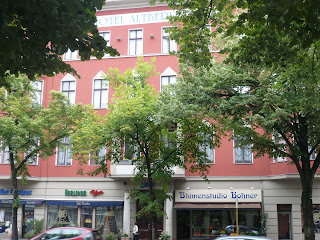I write this in a train speeding across Central Germany away from Berlin. Berlin is a great city and may become the greatest in Europe. It is still a bit new and raw from the continuing reconstruction after reunification but the right path has been set.
Berlin now has a population of around 4.5 million and because it has many “centres of activity” rather than one or two, having a bike to get around has really helped. Despite this, two and a half days is really only a glimpse but still a good glimpse and enough for a desire to return.
As I see it, much of the architectural and planning challenges of reunification have related to integration of the divided city within this historical matrix of multiple centres. There were and are decisions on what to rehabilitate and what and how to renew, particularly in East Berlin. Also, on both sides of the wall, some of the rebuilding of the 50’s, 60’s and 70’s was in haste and ultimately will need to be redone.
An example of the challenges is Wilhelmstrasse. This street and surrounding area was the old centre of both the Federal and Prussian State bureaucracy. Because most of this area and the adjoining Unter den Linden commercial area were in the old East Berlin there was very little renewal until after reunification. Also, because Wilhelmstrasse was close to the Wall, considerable security clearing was done in the East.
During the Nazi era, Wilhelmstrasse was where a lot of the planning for mass extermination occurred. At the only remaining remnant of the Wall, which is just off Wilhelmstrasse, there is an open air photo exhibition of this period. This exhibition, which is called “The Topography of Terror” sets out the challenge of how to renew and rebuild in a good functional sense and yet retain a permanent reminder of this terrible period. The Germans have never wanted to brush anything under the carpet but the immediate post-war period needed more effort on recovery than reflection. It will be interesting to see how this is resolved.
Whilst there are still plenty of cleared spaces, much rebuilding has occurred particularly in the East along Unter den Linden and Alexanderstrasse. So much so that it is the “now” location for Berliners leaving the commercial areas of the old West Berlin a little under patronised, particularly by the young. Totti, Jacqui’s Berlin friend said he doesn’t like everything that is being done but he likes the general direction and the sense of exploration of the renewal. A good attitude, I think.
Since reunification, Berlin has experienced high levels of immigration. Included in this immigration are more than 100,000 Jews from Russia and other Eastern European countries. These people are reinvigorating Jewish life in Berlin. The list of what I saw is as follows:
-The Brandenburg Gate
-Unter den Linden (principle shopping area pre-war and post-reunification)
-Wilhelmstrasse
-Berlin Wall remnant and “Topography of Terror” exhibition.
-Reichstag (a very important symbol of a healthy German democracy – apparently Hitler never set foot in it and ordered it’s burning in 1933.
-Broken church on Budapeststrasser
-Holocaust memorial
-Jewish Museum (spent 4 hours here and could have been much more)
-Berlinische Galerie (excellent modern art museum)
-Tiergarten (immense and great to ride through for a good breakfast appetite)
-Berlin Zoo (very nice but a zoo is a zoo)
-Alexanderstrasse (scene of much recent rebuilding)
-Checkpoint Charlie (very good example of erzarch tourism at work)
-Hotel Altberlin and Potsdamerstrasse (where I stayed – great hotel)
-The new Haupbahnhof (built for the soccer world cup)
Much more to see but the traveller is compelled to move on.
 Inside the Reichstag Dome
Inside the Reichstag Dome(designed by Norman Foster)
 The Reichstag
The Reichstag
 The Holocaust Monument
The Holocaust Monument The Berlin Wall Remnant and the Topography of Terror Display
The Berlin Wall Remnant and the Topography of Terror Display The Tiergarten
The Tiergarten The Brandenburg Gate
The Brandenburg Gate Hotel Altberlin in Potsdamerstrasse
Hotel Altberlin in Potsdamerstrasse







No comments:
Post a Comment